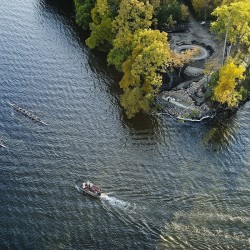Faulty Forensics
In our post-CSI world, where wise-cracking investigators in dark sunglasses solve a case in an hour using cutting-edge techniques, this front-page story was a bit of a shocker: forensic science in the real world is suspect, and its use has sometimes put innocent people behind bars.
A report from the National Academy of Sciences (NAS) revealed that not enough research has been conducted to determine the accuracy and reliability of forensic procedures such as hair analysis, bloodstain patterns, fiber comparison, and fingerprints.
The NAS also concluded that forensic labs are underfunded and understaffed, and technicians are often poorly trained and exaggerate the accuracy of their forensic methods when testifying in court.
The news surfaced just weeks after law students with the Wisconsin Innocence Project won Robert Lee Stinson’s release from prison, after successfully arguing that his 1985 conviction for the murder of a Milwaukee woman was based largely on flawed bite-mark analysis. New analysis showed Stinson’s teeth did not match bite marks on the victim’s body — he was missing a tooth where there was a pronounced mark — and DNA testing of saliva on the victim’s sweater also excluded him.
Lanny Glinberg ’93, JD’07 worked on the case for three years as a UW law student, researching bite-mark evidence alongside his fellow students and reaching a conclusion similar to that from NAS.
“We didn’t come to the Stinson case with a predetermined plan that we would attack this science. We weren’t attacking the bite mark for the sake of attacking the bite mark. We actually spent a lot of time investigating its validity,” says Glinberg, who was among those waiting outside the prison gates when Stinson was freed in January and now works as an assistant district attorney for Dane County.
Stinson’s is one of a growing number of cases where non-DNA evidence is playing a key role in overturning wrongful convictions.
“We’re seeing it in a lot of different kinds of forensic sciences — and even medical investigations — where the premises of the underlying prosecution, it turns out, are flat wrong at worst and disputable at best,” says Keith Findley, co-director of the Wisconsin Innocence Project, which has freed twelve clients and will mark its tenth anniversary in October.
Findley says DNA is the “gold standard” for criminal evidence. But where DNA analysis emerged from the biological sciences, other forensic methods did not, and that’s a major problem in an era of juries swayed by what’s known as the “CSI effect.” The NAS report acknowledges the phenomenon and notes that “jurors have come to expect the presentation of forensic evidence in every case, and they expect it to be conclusive,” even if that’s not possible with some types of evidence.
That problem became clear to Shelley Fite JD’06 as she worked on Stinson’s case and others as a law student. “There are immense opportunities for wrongful convictions where juries think that they’re doing the right thing, because they think they’re doing what science tells them is right,” says Fite, who now works as an appellate criminal defense attorney with the state of Wisconsin public defender’s office.
The vast majority of criminal cases don’t have biological evidence that can be subjected to DNA analysis. But non-DNA cases are much tougher to pursue, Findley says, given the procedural barriers and substantive standards in place that make overturning a conviction difficult. “DNA can overcome all of that,” he says.
Findley says it’s not unusual for the Wisconsin Innocence Project to go to court with non-DNA evidence that establishes a strong claim of innocence and have prosecutors respond, “ ‘This isn’t DNA. This isn’t good enough’ … as if there has to be DNA to prove innocence. But, of course, that’s not the legal standard.”
The Innocence Project will take a client’s case if DNA evidence is available and if testing it can conclusively answer the question of guilt or innocence. Without DNA, a case needs to have enough other evidence that could lead to overturning a conviction.
Due to the legwork involved with having students track down and interview witnesses and look for new evidence, the project won’t take non-DNA cases from states that don’t border Wisconsin.
“DNA cases you can work from a distance. A non-DNA case, you have to hit the street,” Findley says. “That’s just too hard for us to do from a long distance.”
Published in the Fall 2009 issue


Comments
No comments posted yet.